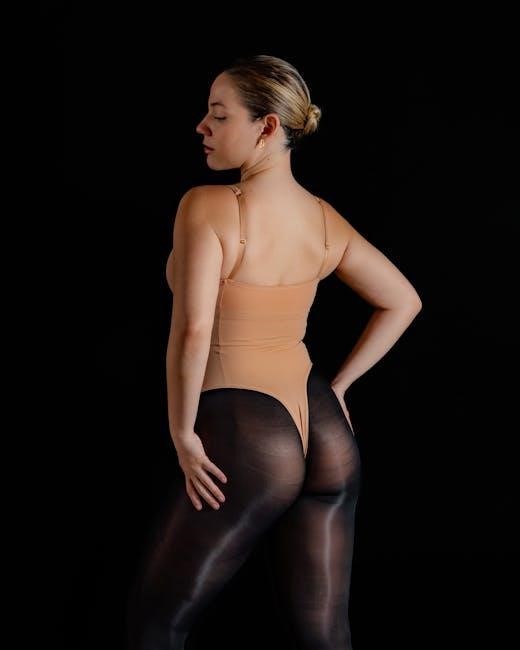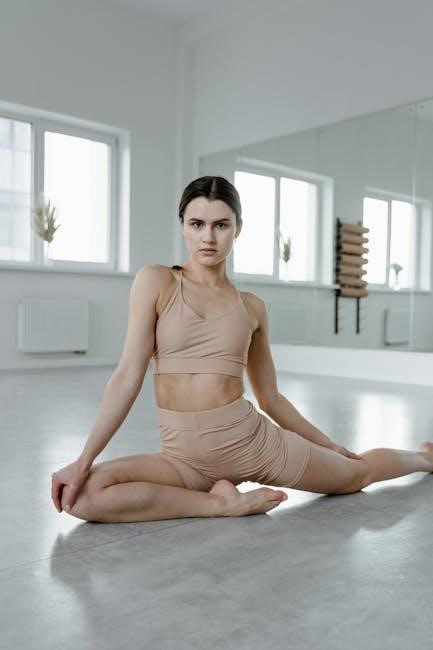Understanding the Capezio leotard size guide is essential for ensuring a comfortable and flattering fit. With detailed charts for adults, children, and tweens, it helps you make informed purchasing decisions.
Why Understanding the Size Guide is Important
Understanding the Capezio leotard size guide is crucial for ensuring a proper fit, which directly impacts comfort and performance. A leotard that is too tight can restrict movement, while one that is too loose may not provide the necessary support. Capezio sizes tend to run small, so it’s important to refer to the chart to avoid sizing errors. Proper fit enhances confidence, allowing dancers and athletes to focus on their craft without discomfort. Additionally, understanding the size guide saves time and effort by reducing the need for returns or exchanges. By measuring accurately and comparing to the chart, you can ensure a leotard that meets your needs for both function and style. This guide is especially helpful for first-time buyers or those transitioning between sizes.
Adult Capezio Leotard Size Chart
The adult Capezio leotard size chart provides detailed measurements for women and men, including chest, waist, hips, and girth. It helps determine the best fit based on body measurements.
Women’s Sizes
Capezio offers a range of women’s leotard sizes, from Extra Small (XS) to Large (L). Each size corresponds to specific chest, waist, hip, and girth measurements. For example, an XS fits a chest of 30-32 inches, a waist of 22-24 inches, hips of 32-34 inches, and a girth of 54-56 inches. Sizes increase gradually, with Small (S) accommodating a chest of 32-34 inches, waist of 24-26 inches, hips of 34-36 inches, and girth of 56-58 inches. Medium (M) fits a chest of 34-36 inches, waist of 26-28 inches, hips of 36-38 inches, and girth of 58-60 inches. Large (L) is designed for a chest of 36-38 inches, waist of 28-30 inches, hips of 38-40 inches, and girth of 60-62 inches. These measurements ensure a tailored fit for various body types. Always consider the fit preference—tight or relaxed—when selecting a size. If unsure, sizing up is often recommended for comfort and mobility.
Men’s Sizes
Capezio offers a variety of men’s leotard sizes to cater to different body types. The sizing ranges from Small (S) to Extra Large (XL), ensuring a comfortable and precise fit. For men, the chest measurement is a key factor in determining the correct size. A Small size typically fits a chest of 34-36 inches, while Medium (M) accommodates 36-38 inches, and Large (L) fits 38-40 inches. Extra Large (XL) is designed for a chest of 40-42 inches. Capezio leotards are known to fit snugly, so many customers opt to size up for added comfort and flexibility. It’s important to refer to the official size chart and consider personal fit preferences when making a selection. This ensures the leotard provides the necessary support and mobility for various activities.

Child and Tween Capezio Leotard Size Chart
This section provides detailed sizing information for children and tweens, ensuring a perfect fit for growing bodies. Measurements include chest, waist, hips, and girth to accommodate different growth stages.
Girls’ Sizes
Capezio offers a wide range of sizes for girls, ensuring a perfect fit for various body types and growth stages. The size chart is divided into numerical and alphabetical categories, with measurements for chest, waist, hips, and girth. Sizes typically range from Toddler to Tween, with specific dimensions to accommodate growing bodies. For example, Toddler sizes start at 20-21″ chest and 19-20″ waist, while larger sizes gradually increase in measurements. The chart also includes tips for choosing the right size, such as considering whether the leotard will be worn for dance, gymnastics, or casual use. Capezio sizes tend to run small, so many customers opt to size up for a more comfortable fit. This section helps parents and guardians make informed decisions when selecting leotards for their children.
Tween Sizes
Capezio’s tween sizes are designed to accommodate the transitional growth phase between childhood and adolescence. These sizes are specifically tailored to fit young dancers and athletes who require a leotard that offers both comfort and support. The tween size chart typically includes categories such as Tween Intermediate and Tween Medium, with measurements that gradually increase to match growth spurts. For example, chest measurements may range from 28-30″ to 32-34″, while waist and hip measurements follow a similar progression. Capezio’s tween sizes are known to run slightly small, so many customers find it helpful to size up for a more relaxed fit. The chart also provides guidance on girth measurements, ensuring the leotard stays securely in place during movement. This section is particularly useful for parents and guardians seeking the perfect fit for their growing tweens.

How to Measure for the Best Fit
Measuring for a Capezio leotard involves taking accurate chest, waist, hip, and girth measurements. Use a flexible tape measure and ensure the fit is snug but not restrictive for optimal comfort.
Measuring the Chest
Measuring the chest is crucial for determining the correct leotard size. Wrap a flexible tape measure around the fullest part of the bust, keeping the tape parallel to the floor. Ensure the tape is snug but not too tight, as this can restrict movement. For accuracy, take the measurement while standing upright and wearing a well-fitting bra. Capezio leotards are designed to fit closely, so it’s important to get this measurement right to avoid any discomfort or gapping. If your measurement falls between sizes, consider the fit you prefer—tight for support or relaxed for ease. This step ensures your leotard provides the right balance of comfort and performance.
Measuring the Waist
To measure your waist for a Capezio leotard, locate the natural waistline, which is typically just above the navel. Use a flexible tape measure and wrap it around this area, ensuring it remains level and parallel to the floor. The tape should be snug but not overly tight, as this could lead to discomfort. Stand upright with your feet hip-width apart and take a normal breath to ensure accuracy. If your measurement falls between sizes, consider whether you prefer a tighter fit for support or a slightly looser fit for ease of movement. This measurement is vital for ensuring the leotard sits comfortably and provides the right level of support without feeling restrictive. Accurate waist measurement helps guarantee a leotard that flatters and performs well during activities.
Measuring the Hips
To accurately measure your hips for a Capezio leotard, stand upright and locate the widest part of your hips, typically about 7-9 inches below your waistline. Use a flexible tape measure and wrap it around this area, ensuring it remains level and parallel to the floor. The tape should be snug but not restrictive, allowing for a full range of motion. Take note of the measurement and compare it to the Capezio size chart to determine the best fit. If your hip measurement falls between sizes, consider your personal preference for fit—tighter for more support or slightly looser for comfort. Accurate hip measurement is crucial for ensuring the leotard provides a flattering silhouette and allows for optimal movement during dance or exercise. This step, combined with other measurements, helps you choose a leotard that feels and looks great.
Measuring the Girth
To measure your girth for a Capezio leotard, wrap a flexible tape measure around your torso in a straight line from one hipbone to the other, passing under your arms and across your shoulder blades. Stand upright and relax your arms by your sides. The tape should be snug but not restrictive, ensuring it doesn’t compress your body. Take note of the measurement and compare it to the Capezio size chart. The girth measurement helps determine how the leotard will fit around your body, ensuring it stays in place during movement. For accuracy, avoid slouching or holding your breath. If your girth measurement falls between sizes, consider your activity level and desired fit—tighter for performance or slightly looser for comfort. This measurement, combined with others, ensures a leotard that supports and flatters your body. Proper girth measurement is key to a secure and comfortable fit.

Common Sizing Tips and Tricks
Most Capezio leotards fit small, so consider sizing up for comfort. Measure accurately, check the fit chart, and choose based on your activity level and fabric preference.
Considering the Fit: Tight vs. Relaxed
When choosing a leotard, decide between a tight or relaxed fit based on comfort and activity. A tight fit offers support and minimizes movement, ideal for performance or intense workouts. A relaxed fit provides comfort for casual wear or rehearsals. Capezio styles often run small, so sizing up may be necessary for a looser fit. Measure accurately, focusing on chest, waist, and hips. Consider fabric stretch and personal preference. If unsure, opt for a slightly larger size to avoid restriction. Proper fit ensures optimal performance and confidence. Always refer to the size chart for precise measurements and adjust based on your needs and activity level.
When to Size Up
Capezio leotards are known to fit snugly, and many customers find it beneficial to size up for a more comfortable fit. If you prefer a relaxed fit or have a broader shoulder or chest area, sizing up is recommended. Additionally, if you have a muscular build or are taller, a larger size may provide better coverage and flexibility. Consider the fabric type as well—thicker or less stretchy materials may feel tighter. If you’re between sizes or unsure, sizing up ensures ease of movement and prevents the leotard from feeling restrictive. Always refer to the size chart and your measurements to make the best decision. Sizing up can enhance comfort and performance, especially for activities requiring a full range of motion.

Frequently Asked Questions
Many customers inquire about the best practices for sizing, especially since Capezio leotards tend to run small. A common question is whether to size up for comfort, with most recommending doing so for a relaxed fit. Another frequently asked question is about measuring techniques, with emphasis on ensuring accurate chest, waist, and hip measurements. Some wonder about the differences between women’s, men’s, and children’s sizing charts, while others seek advice on choosing the right size when purchasing online without trying it on. Additionally, there are inquiries about the fit of specific styles, such as whether certain leotards are designed to be more form-fitting or if they offer more coverage. Lastly, customers often ask about return policies in case the size doesn’t fit as expected, making it important to review before making a purchase.